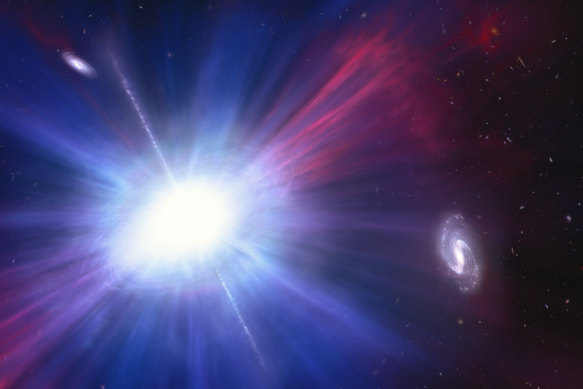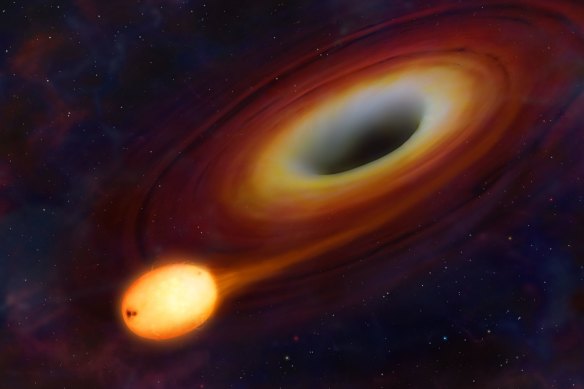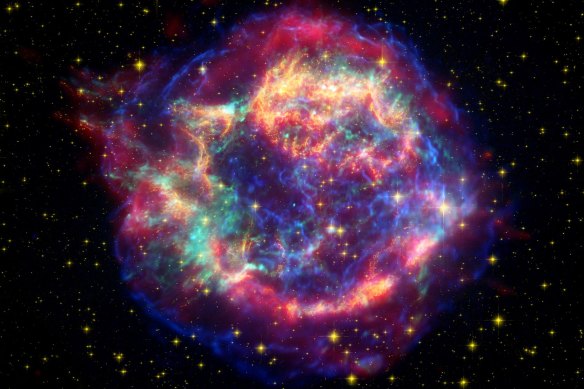
Save articles for later
Add articles to your saved list and come back to them any time.
A colossal cosmic cataclysm exploding with the intensity of an entire galaxy of stars has gobsmacked astronomers, who say the detonations of hot, blue-white light upend our understanding of how the laws of physics are supposed to operate.
And the puzzling phenomenon has been named after Australia’s largest carnivorous marsupial.
An artist’s impression of an LFBOT, explosions in space brighter than entire galaxies made up of hundreds of billions of stars.Credit: NASA, ESA, NSF’s NOIRLab, Mark Garlick , Mahdi Zamani
Last year, global astronomers seized on telescope data that picked up evidence of an explosion called a luminous fast blue optical transient, or LFBOT. Only a handful of these blasts, which explode with the energy of 100 billion stars, have been discovered since the first in 2018.
The new LFBOT was labelled AT2022tsd. Running with the last three letters of that technical label, astronomers nicknamed the blast “the Tasmanian devil”.
But the bizarre thing about the Tasmanian devil was that it kept exploding, after the force of the initial blast should have obliterated whatever sparked the explosion.
“An event like this has never been witnessed before,” said co-author of the Nature research that reported the phenomenon, Professor Jeff Cooke.
At the Swinburne University of Technology and the ARC Centre of Excellence for Gravitational Wave Discovery, Cooke studies supernovas, the massive, fiery death blooms of stars.
“It’s really hard to fathom how much energy supernovas unleash, it’s just enormous, giant numbers,” he said.
“This thing is like a supernova explosion. But LFBOTs are about 100 times brighter.”
A team of international astronomers met to analyse images of the Tasmanian devil generated by 15 telescopes from across the globe and in space. The images showed another bright burst following the initial explosion, and then another.
A black hole ripping apart a nearby star in its orbit could be the source of the extraordinary pulses of energy.Credit: Mark A. Garlick
The Tasmanian devil had flared 14 times over 120 days, probably only a fraction of the actual number of repeat explosions. A cataclysm of that ferocity should’ve only occurred once.
“No one really knew what to say,” said Anna Ho, lead author and assistant professor of astronomy at New York’s Cornell University.
“Something so fast, and the brightness as strong as the original explosion months later, in any supernova or LFBOT – we’d never seen that, period, in astronomy.”
The flashes were rapid, occurring over minutes compared to weeks-long supernovas.
“It pushes the limits of physics because of its extreme energy production, but also because of the short duration bursts,” Cooke said.
The remnants of supernova Cassiopeia A. Supernovas brighten over a scale of weeks, unlike the rapid flashes of the Tasmanian devil.Credit: NASA
“Light travels at a finite speed. As such, how fast a source can burst and fade away limits the size of a source, meaning that all this energy is being generated from a relatively small source.”
Cosmic material pummelling a dense neutron star or black hole created by the original explosion could be unleashing the intense flares, one theory goes. Another proposes that a black hole is in the process of ripping apart a white dwarf star, hurling off huge plumes of energy.
Cooke said the extraordinary finding opened up astronomers’ eyes to the possibility of new discoveries.
“Are there other things there that we can find if we have the technology? It makes you think: what does the universe have to offer here?”
The Examine newsletter explains and analyses science with a rigorous focus on the evidence. Sign up to get it each week.
Most Viewed in National
From our partners
Source: Read Full Article


